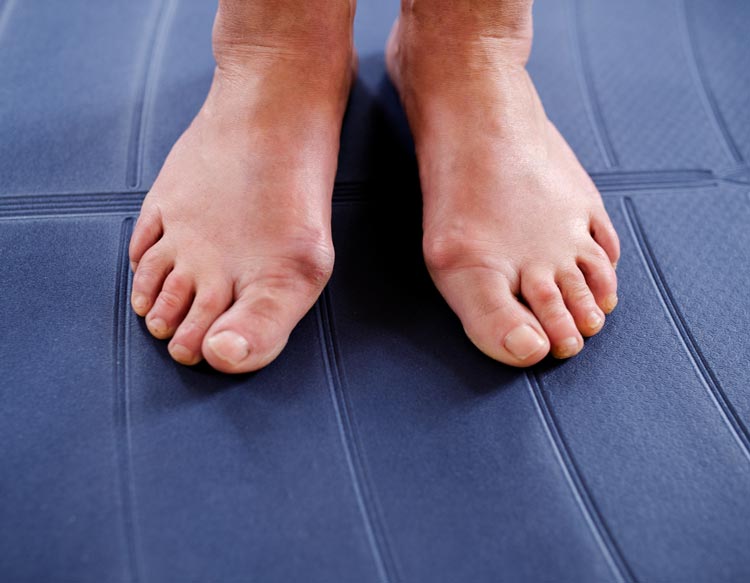Bunions are not just a bump! This is common misconception when it comes to bunion deformities. Bunions are caused by a shift of the 1st metatarsal (the bone behind the big toe) away from the 2nd metatarsal. This causes the big toe joint to be out of alignment. This is the area where the bump is seen. Over time the shift continues with the 1st metatarsal moving in and the big toe moving out. A rotation of the metatarsal can often occur simultaneously. It becomes more difficult to find comfortable shoes, redness and swelling can occur in the area and sometimes a nerve can be entrapped to create pain with the nerve. Many times, the bump is noticed before you have the pain associated with it. Bunions frequently have a genetic component and are not just caused by wearing the wrong shoes. Call today to discuss treatment options! Frequently orthotics and proper shoe gear can be helpful in delaying or preventing progression. In some cases, surgical intervention is needed to help with the pain and improve the alignment. Dr. Nelson can take x-rays and evaluate your concerns. She is also trained in the technique of Lapiplasty which corrects the multiple planes simultaneously.
Call the Foot & Ankle Specialists of Ames at (515) 444-2390 or email info@fas-ames.com to make an appointment!
Tailors bunions are bumps that can form on the outside of the foot at the 5th metatarsal. The concept is like a bunion developing but in this case the 5th metatarsal shifts away from the 4th metatarsal. The 5th digit can develop a hammertoe as well creating pain in both the 5th toe and along the 5th metatarsal (the bone behind the 5th digit). A bursa can also develop in this area creating inflammation and swelling to the area.
Call the Foot & Ankle Specialists of Ames at (515) 444-2390 or email info@fas-ames.com to make an appointment!
Hammertoes occur due to tendon imbalances of the toes. The toes can contract up or sideways. Sometimes they overlap the toes next to them making shoe gear uncomfortable. Genetics can play a role but also more systemic diagnoses such as rheumatoid arthritis or neurological diseases can contribute to the development a well. A bunion deformity can put pressure on the 2nd toe and pushes the toe up to form a hammertoe. As hammertoes develop, they can be become irritated by increased areas of friction and pressure that leads to painful calluses. As the hammertoes worsen, they become more rigid. Severe cases or if not responding to conservative options may be candidates for surgical procedures.
Call the Foot & Ankle Specialists of Ames at (515) 444-2390 or email info@fas-ames.com to make an appointment!
This is not as commonly known when compared to plantar fasciitis or bunions but it is something common that we see. It is frequently diagnosed as a neuroma because they can have similar symptoms. An overuse injury that typically occurs of a ligament (the plantar plate) at the base of the 2nd toe that connects to the 2nd metatarsal on the bottom of the foot. The ligament can get stretched and eventually lead to tears. Some foot types can be more at risk such as if you have bunions, a long second toe, a tight Achilles tendon to name a few. Early in the presentation, conservative treatment can be helpful such as taping a toe to help stabilize it or orthotics. If plantar plates tears go untreated, the digit can move out of the joint and dislocate.
Call the Foot & Ankle Specialists of Ames at (515) 444-2390 or email info@fas-ames.com to make an appointment!
There are many tendons that are in your feet and ankles. That can be torn or ruptured. This can occur after you twist your ankle, miss a step or due to more repetitive injuries. If you have an injury and feel a “pop” this could be damage to the ligaments, tendons or the bone. This can lead to instability, weakness and chronic pain. A rupture to a tendon needs to be surgically repaired to regain the strength and function of the tendon. It limits your activity and recovery can be prolonged without seeking evaluation and treatment. We can help get you the early treatment that is needed to get you back on your feet.
Call the Foot & Ankle Specialists of Ames at (515) 444-2390 or email info@fas-ames.com to make an appointment!
A cavus foot (high arch foot) has the opposite appearance of a flat foot. With this foot type the arch doesn’t contact the ground when standing. A cavus foot type can be part of development or a part of a neurological condition. If there is change to the appearance or the foot starts to feel weak, then this should be evaluated. Pain may present in the heel, arch, or ball of the foot due to increased pressure and strain across the arch. There can be an increased risk for 5th metatarsal stress fractures, ankle sprains or peroneal tendon injury due to the mechanics of the foot. A high arch foot tends to supinate (roll out on the foot) that may make it more prone to rolling an ankle. In time, this can lead to increased ankle instability or tendon tears that progress more slowly. A high arch foot has different degrees of severity. Frequently this foot type needs increased support from an orthotic due to the shoe not being able to support the foot enough. A more severe high arch would benefit from a more custom made orthotic due to many over the counter arches not quite able to give adequate support.
Call the Foot & Ankle Specialists of Ames at (515) 444-2390 or email info@fas-ames.com to make an appointment!

Monday 8:00-4:30
Tuesday 8:00-4:30
Wednesday 8:00-4:30
Thursday 8:00-4:30
Friday 8:00-3:00
Web Design and Development by Saltech Systems